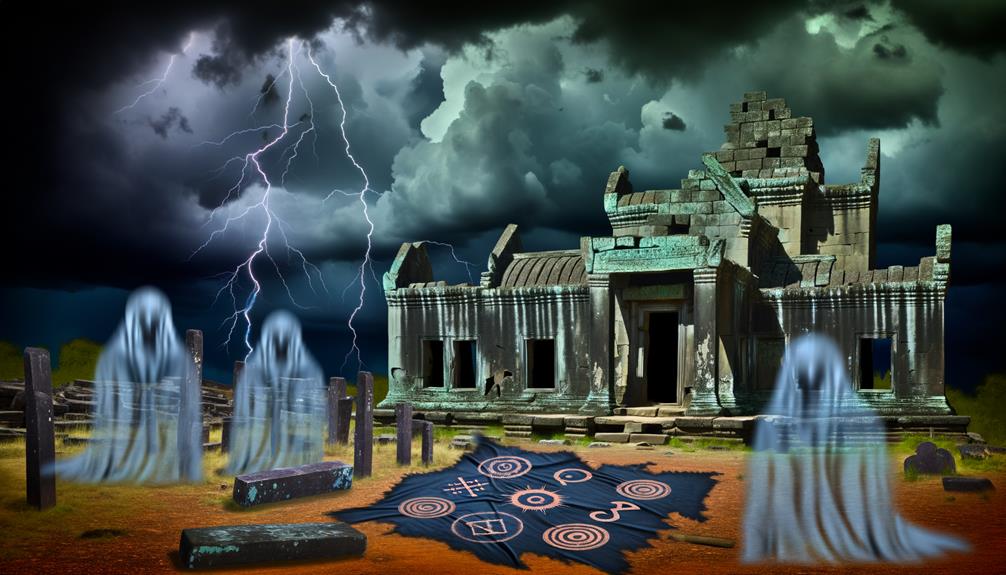Abomination of Desolation Bible Verse Meaning: End Times!
The ‘Abomination of Desolation‘ is a term from the Book of Daniel (Daniel 9:27, 11:31, and 12:11) that refers to an act of extreme sacrilege resulting in desolation. Historically, it is linked to Antiochus IV Epiphanes, who defiled the Second Temple by erecting an altar to Zeus in the 2nd century BCE.
Jesus referenced this event in Matthew 24:15 and Mark 13:14, warning of future desecrations and divine judgments, such as the Roman destruction of Jerusalem in 70 AD. The phrase encapsulates profound prophetic and eschatological implications, indicating patterns of divine retribution and alerting believers to future tribulations and trials.
Continuing in this vein reveals deeper theological insights.

Key Takeaways
- The ‘Abomination of Desolation’ refers to sacrilege causing desolation, originally prophesied in the Book of Daniel (Daniel 9:27, 11:31, 12:11).
- Jesus highlights this prophecy in Matthew 24:15 and Mark 13:14, warning of Jerusalem’s impending destruction and urging vigilance.
- Historically, it relates to Antiochus IV Epiphanes’ desecration of the Second Temple in 167 BCE.
- The prophecy also connects to the Roman destruction of Jerusalem in 70 CE, illustrating recurring divine judgment.
Abomination of Desolation Bible Verse Meaning: End Times Prophecy and Desecration
| Aspect | Explanation |
|---|---|
| Source | Mentioned in Daniel 9:27, 11:31, 12:11, and by Jesus in Matthew 24:15 and Mark 13:14 |
| Meaning | Refers to a defiling or desecrating event in a holy place, often interpreted as a sign of great spiritual crisis |
| Prophetic Context | In Daniel, it is tied to the destruction and desecration of the temple, possibly pointing to historical or future events |
| Jesus’ Warning | Jesus speaks of this event as a sign that precedes great tribulation, urging believers to be alert and flee (Matthew 24:15) |
| End Times Significance | Many view it as a key event in biblical end-times prophecy, signaling the approach of great trials and God’s ultimate judgment |
| Interpretations | Various interpretations connect it to historical events like the destruction of the temple in 70 A.D., or future events linked to the Antichrist |
Origin in the Book of Daniel

Tracing its origin to the prophetic visions in the Book of Daniel, the term ‘Abomination of Desolation‘ emerges as a pivotal concept within the eschatological framework of Judeo-Christian scriptures.
Mentioned in Daniel 9:27, 11:31, and 12:11, this phrase denotes a sacrilege that causes desolation, often interpreted as a defilement of the holy temple.
The historical context situates these events amid the tumultuous period of Antiochus IV Epiphanes, whose actions in the 2nd century BCE desecrated the Second Temple by erecting an altar to Zeus.
This historical sacrilege serves as a typological precursor to future prophetic fulfillments, underpinning later theological interpretations and offering a lens through which subsequent apocalyptic literature is understood.
Jesus’ Reference in the Gospels

In the Synoptic Gospels, Jesus’ reference to the ‘Abomination of Desolation’ in Matthew 24:15 and Mark 13:14 underscores its significance in the context of eschatological prophecy and the anticipated tribulations preceding the end times.
These references serve to:
- Highlight Fulfillment of Daniel’s Prophecies: Jesus connects the past with future events, emphasizing continuity in divine revelation.
- Warn of Impending Destruction: Specifically, the destruction of Jerusalem and the temple, which historically occurred in 70 AD.
- Call for Vigilance: Believers are urged to be watchful and discerning of the signs of the times.
- Encourage Perseverance: Followers are reminded to endure faith amidst persecution and trials.
These passages provide a profound understanding of Jesus’ eschatological teachings.
Historical Interpretations

Historically, interpretations of the ‘Abomination of Desolation‘ have varied, reflecting diverse theological perspectives and historical contexts.
Early Jewish exegesis often identified this term with the desecration of the Second Temple by Antiochus IV Epiphanes in 167 BCE, as described in Daniel’s prophecies.
In Christian thought, many theologians have linked it to the Roman destruction of Jerusalem in 70 CE, drawing on Jesus’ predictions in the Gospels.
Additionally, some Protestant Reformers saw it as a symbolic critique of certain medieval church practices.
Variations in interpretation highlight the term’s flexible application across epochs, influenced by contemporary events and doctrinal stances, making it a rich subject for ongoing theological and historical analysis.
Theological Perspectives

Theological perspectives on the ‘Abomination of Desolation‘ have evolved considerably from early scholarly interpretations to contemporary theological views.
Early scholars like Jerome and Augustine contextualized the prophecy within the framework of historical events, while modern theologians often consider eschatological implications and symbolic meanings.
This section will explore how these varied interpretations have shaped our understanding of this enigmatic biblical prophecy.
Interpretations by Early Scholars
Early scholars offered diverse theological perspectives on the ‘Abomination of Desolation’ verse, rooted in scriptural analysis and historical context. Their interpretations often reflected a deep engagement with biblical texts and contemporary events.
Importantly, their insights can be categorized into four main perspectives:
- Antiochus IV Epiphanes: Many scholars identified the ‘Abomination of Desolation’ with the desecration of the Jerusalem Temple by Antiochus IV in 167 BCE.
- Roman Destruction: Some linked the prophecy to the Roman destruction of the Second Temple in 70 CE.
- Eschatological View: Others interpreted it as a future apocalyptic event, signifying the end times.
- Typological Interpretation: A few saw it as a recurring symbol of ultimate sacrilege against God throughout history.
These interpretations collectively enrich our understanding of this complex biblical prophecy.
Modern Theological Views
In contemporary theological discourse, interpretations of the ‘Abomination of Desolation‘ continue to evolve, drawing from advanced scriptural exegesis and the latest historical scholarship.
Scholars now often examine the term through a multi-faceted lens, incorporating insights from Second Temple Judaism and early Christian eschatological thought.
Modern theologians debate whether this prophetic imagery exclusively pertains to past events, such as the desecration of the Jerusalem Temple, or also foreshadows future apocalyptic scenarios.
Some posit that the ‘Abomination’ symbolizes broader themes of sacrilege and divine judgment applicable across epochs.
Prophetic Implications

The prophetic implications of the ‘Abomination of Desolation‘ encompass its eschatological significance as portrayed in biblical prophecy, where it is often associated with end-times scenarios.
Historically, scholars have identified various fulfillments, such as the desecration of the Second Temple by Antiochus IV Epiphanes, providing a contextual backdrop for understanding its recurrence in future prophetic events.
This multi-faceted interpretation necessitates a thorough examination of scriptural texts and historical records to anticipate its potential reappearance in eschatological narratives.
Eschatological Significance Explained
Understanding the eschatological significance of the ‘Abomination of Desolation’ involves examining its prophetic implications within the broader context of biblical prophecies and historical events. The term, originating from Daniel’s visions, is pivotal in eschatological discourse, pointing to a future event of profound spiritual and historical impact.
Scriptural analysis reveals four key elements:
- Daniel’s Prophecy: Foretells a desecration in the holy place, triggering a period of great tribulation (Daniel 9:27).
- Jesus’ Reference: In Matthew 24:15, Jesus warns of its recurrence, signifying imminent peril.
- Apostle Paul’s Insight: Connects it to the antichrist’s manifestation (2 Thessalonians 2:4).
- Revelation’s Vision: Echoes Daniel, depicting end-time abominations (Revelation 13:14).
These components collectively underscore its critical role in eschatological narratives.
Historical Fulfillment Context
Examining the historical fulfillment context of the ‘Abomination of Desolation’ reveals its prophetic implications as seen through pivotal events in Jewish history, such as the desecration of the Second Temple by Antiochus IV Epiphanes and the Roman destruction of Jerusalem in 70 AD. These events serve as a tangible manifestation of prophetic utterances, providing a hermeneutical lens for interpreting scriptural passages. Antiochus’s actions in 167 BC prefigured later desolations, echoing through centuries as a paradigm of sacrilege. Similarly, the Roman siege and subsequent ruin of Jerusalem underscored the severity of divine judgment and the fulfillment of biblical prophecy.
| Event | Date | Significance |
|---|---|---|
| Desecration by Antiochus IV | 167 BC | Fulfillment of Danielic prophecy |
| Roman destruction of Temple | 70 AD | Realization of Jesus’ prophecy in Matthew 24 |
| Maccabean Revolt | 167-160 BC | Restoration of temple worship |
| Jewish Wars | 66-73 AD | Context for prophetic fulfillment |
| Establishment of Rabbinic Judaism | Post-70 AD | Response to temple destruction |
Thus, these historical fulfillments underscore the prophetic gravity of the ‘Abomination of Desolation.’
Future Prophetic Events
In light of historical precedents, future prophetic events concerning the ‘Abomination of Desolation’ invite rigorous theological scrutiny and eschatological anticipation. Scholars often analyze this concept through a composite lens of scriptural exegesis and prophetic foresight.
Scriptural Correlation: Future events are often evaluated against biblical passages such as Daniel 9:27 and Matthew 24:15, which suggest a recurring theme of desecration.
Historical Recurrence: Examining historical fulfillments like Antiochus IV and the Roman destruction of the Temple provides a template for future occurrences.
Eschatological Timelines: Prophetic timelines in Revelations and Daniel offer clues about the sequence of end-time events.
Theological Implications: Understanding these prophecies helps believers prepare spiritually for potential future trials and tribulations.
This analytical approach fosters deeper understanding among those anticipating future fulfillment.
Modern-Day Significance

The concept of the Abomination of Desolation, as referenced in biblical prophecy, continues to hold significant theological and eschatological implications for contemporary believers.
Rooted in Daniel’s apocalyptic visions and referenced by Jesus in the Gospels, this term signifies a pivotal moment of sacrilege and divine judgment.
In modern times, it serves as an essential interpretive key for understanding end-times scenarios within various Christian eschatological frameworks.
For many, it underscores the importance of spiritual vigilance and moral integrity in an era perceived as increasingly secular and morally ambiguous.
Historical events, such as the desecration of the Second Temple, provide a backdrop that informs current interpretations, emphasizing the recurring nature of divine prophecy and its relevance to contemporary faith practices.
Scholarly Debates

Among theologians and biblical scholars, the interpretation of the Abomination of Desolation has sparked extensive debate, particularly regarding its historical fulfillment and eschatological implications.
The discourse often centers around:
- Historical Context: Some argue it refers to Antiochus IV Epiphanes’ desecration of the Second Temple in 167 BCE.
- Prophetic Fulfillment: Others see it as predicting the Roman destruction of Jerusalem in 70 CE.
- Futurist Perspective: A segment of scholars posits that the prophecy points to future events yet to occur.
- Symbolic Interpretation: Another view suggests it symbolizes broader spiritual apostasy rather than a specific historical event.
Each perspective offers a unique lens, contributing to the rich tapestry of theological and eschatological discourse surrounding this enigmatic biblical prophecy. Some interpretations focus on historical and political events, while others emphasize symbolic and metaphorical elements. Together, these diverse perspectives provide a comprehensive understanding of the Book of Revelation and its implications for Christian theology and eschatology. Through these various lenses, the complex symbolism, prophecy, and insights into life’s seasons explained by the text are brought to light, enriching the ongoing dialogue and interpretation of this profound biblical book.
Conclusion
The ‘abomination of desolation‘ emerges from the prophetic visions in Daniel, gains prominence through Jesus’ forewarnings in the Gospels, and traverses historical, theological, and prophetic landscapes.
Ironically, a term rooted in ancient texts continues to provoke modern scholarly discourse, illustrating the timeless nature of biblical enigmas.
Despite exhaustive exegesis and rigorous debate, its full meaning remains elusive, underscoring the perpetual quest for divine understanding amidst human limitations.






